 I've read The Scarlet Letter. I've read The Lord of the Rings and The Hobbit. I've even read War and Peace (in translation, of course). But I have never made it through Moby Dick. Yes, dear reader, at the time I put down Herman Mellville's leviathan American novel in college, Ishmael had yet to put foot on the whaling ship Pequod. If you are in the same (metaphorical) boat, take heart. Moby Dick, or, The Whale, is also "the great unread American novel"-- we are not alone.
I've read The Scarlet Letter. I've read The Lord of the Rings and The Hobbit. I've even read War and Peace (in translation, of course). But I have never made it through Moby Dick. Yes, dear reader, at the time I put down Herman Mellville's leviathan American novel in college, Ishmael had yet to put foot on the whaling ship Pequod. If you are in the same (metaphorical) boat, take heart. Moby Dick, or, The Whale, is also "the great unread American novel"-- we are not alone.The Big Read
A recently launched, star-studded project from the UK's Plymouth University aims to change our ways. Two years in the making, the Moby-Dick Big Read is a brand-new audiobook version of the 135-chapter novel; a new chapter is released daily as a downloadable mp3 (on the Big Read website or through iTunes). Dr. Philip Hoare, artist in residence at Plymouth University’s Marine Institute and coordinator of the project, said: “Moby-Dick is a novel that everyone has heard of but very few people have read. This is a way of introducing it to a new audience and is something people can pick up as and when they choose – it is completely suited to the digital age.”
So who is reading to us? Perhaps the biggest name is British Prime Minister David Cameron, who reads Chapter 30, but there are also Tilda Swinton (Chapter 1), Benedict Cumberbatch (the latest BBC Sherlock Holmes, Ch. 58), Simon Callow (Ch. 9) and American author Nathaniel Philbrick (Why Read Moby Dick?, In the Heart of the Sea, and Revenge of the Whale, Ch. 14) plus 130 more, including a fisherman, a vicar and a 12-year-old boy!
 Why Read Moby Dick?
Why Read Moby Dick? This is the huge question asked and answered in Nathaniel Philbrick's short book of the same title, newly arrived in the Paideia Library. In 4-5 page chapters, Philbrick gives us background on Melville, his family and youthful experiences, influences on the writing of Moby Dick, information on Nantucket and the 19th century whaling industry, and argues that though not "a page turner, the book is a repository not only of American history and culture but also of the essentials of Western literature." I'm intrigued. And a context and guide to this novel is only going to help make sense of what I mostly know only through modern culture snippets (Ahab symbolizes the mad pursuit of an end regardless of 'collateral damage,' right? And who in 21st century America hasn't heard of Starbuck(s)?)
A Great Course
Anyone wanting to delve even more deeply into the heart of Moby Dick can listen to the 4 audio lectures by Prof. Arnold Weinstein on the Classics of American Literature Great Courses series in the library's audiobook collection. Each of the 30 minute lectures focuses on a different aspect of the novel, from "The Making of Moby Dick" to "The Tragedy of Perspective."
My Progress So Far . . .
I'm so glad you asked :-) In a thrilling turn of events (I've now listened up through Ch. 26), Ishmael and Queequeg are on the Pequod and out in the open sea! Nobody ever told me that Ishmael was funny. Who knew? They have yet to meet crazy Captain Ahab -- that's coming up in the next couple of chapters. My listening over over Thanksgiving break will include Chapter 30, "The Pipe," the Prime Minister's chapter (and a very short chapter indeed, at just under 2 minutes).

More (and Less)
Apparently the Moby Dick virus is pretty darn contagious -- by November 11 the project had logged over a million listeners. A writer in Glasgow called Eva Stalker has a blog with weekly updates on each chapter release, including brief information on each reader. If you're curious about the story behind the story, follow her at http://evastalker.com.
And if this is all still just too much, just this month, brothers Jack and Holman Wang released Cozy Classics Moby Dick. I kid you not -- Moby Dick in 12 words and 12 cozy illustrations. Now that's minimalist!
Have you read Moby Dick? Or have you always meant to? Either way, I do recommend trying out this podcast release of the novel. If you do, let me know what you think!

